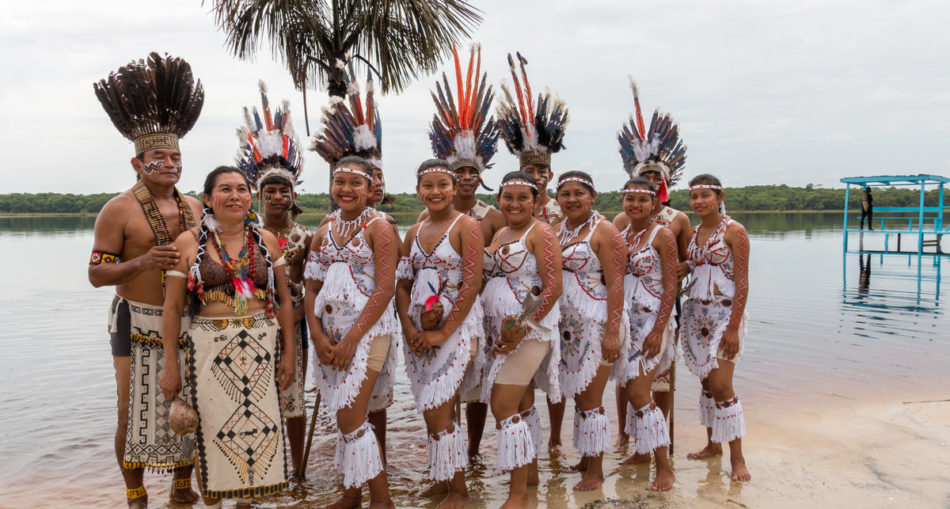According to a source from the US Library of Congress over 35,000 years ago, the indigenous people trekked across many miles and faced perilous weather conditions as they made their way to Guyana. One of the first tribes to have settled on our land was the Arawaks. The Arawaks were extraordinary people with a rich and complex cultural heritage. Let us take a look at their unique agricultural, social and religious system.
Origin of the Name
The Arawaks were originally called the Taino Tribe, Taino meaning “Man of the good” which is fitting given their friendly and hospitable disposition. They were renamed Arawaks by European invaders.
Language
The Arawaks spoke a language known as “Arawakan” or “Lokono”. Some examples of words in the Arawakan language are: ‘Hadali’ meaning Sun, ‘Kathi’ meaning Moon, ‘Hiaro’ meaning Woman, and ‘Wadili’ meaning Man.
Lifestyle
The Arawak tribe was a very kind-spirited society. They were usually seen as being very happy, friendly and had a well-organized societal hierarchy. The leader of their group, known as the Cacique or Chief was responsible for the entire tribe. He painted his skin with red dye, wore a headdress that was made of colourful parrot feathers and he wore jewelry made from precious gems found around the forest. Although the Cacique was appointed to oversee the entire village there were also sub-caciques who held similarly honourable positions and were responsible for sections of the tribe.
Housing and Dress
A majority of the Arawakans, lived in circular benabs made from mud and composed of palm leaves which acted as a roof; straw was also used alongside wood to make the walls of these huts. The Cacique’s home was easily distinguishable since it had a more unique architectural design. The chief’s house was rectangular in shape, considerably larger, and also had a porch. Entering these homes you did not find much comfortable furniture, instead, there were hammocks made of cotton and banana trees laid across the floor which were used for sleeping.
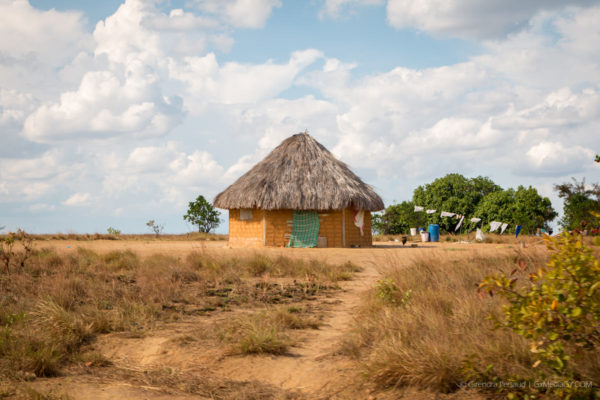
Picture depicting an Arawakan home.Source: https://photos.girendra.com
The men and women fashioned small pieces of fabric to cover their loins. This fabric was often made of cotton or feathers woven together. They would paint their bodies and adorn themselves with shells and other decorations.
Food and Agriculture
The Arawaks were Guyana’s first horticulturists, skilled in farming, fishing and the occasional hunting. After they arrived they settled near coastal lands close to the Hosororo Creek on the Aruka River and also occupied land space near the Corentyne River. They relied heavily on fishing, they produced a variety of tools for fishing such as nets made from cotton, throwing spears and arrows and bows made of wood. When hunting birds they would mimic the sound of their chirps in order to lure and trap them in nets. They commonly hunted deer, labba, tapir, peccary or wild hog, agouti and turtles.
The Arawaks developed a system of agriculture in which crops were grown on large, raised mounds known as “concuo”. They placed leaves around the concuo to prevent soil erosion and fixed a large variety of crops to ensure that something would grow despite weather conditions. The chief crops grown were maize or corn, cassava, sweet potatoes and yam. The cassava crop was used to make cassava bread which would be enjoyed with pepperpot made from labba and other meats. Cotton was also cultivated; it was used to make cloth and hammocks used for resting after a hard day at work.
Transportation
Since the Arawaks resided mostly by the riverside they required transportation for the water so they made canoes also known as ‘dug-outs’ which were given this title because of their construction technique of hollowing out a single tree trunk.
Fun Fact: According to a publication published by Bob Corbett titled “The History of Haiti” The canoes or dug-outs were so HUGE that they held at least 70 to 80 people at once.
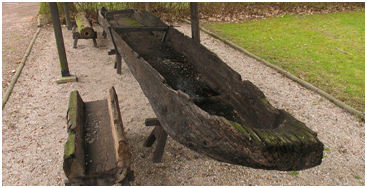
Picture depicting a replica of a Dugout/Canoe. Photo Source: Author- Mohylek (https://commons.wikimedia.org/wiki/File:Dlubanka_swidnica_2.jpg)
Special Activities
Dance
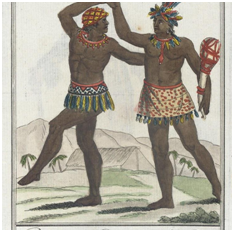
Photo of two Arawakan men dancing. Source:https://www.flickr.com/photos/wikimediacommons/16402102415
The Arawaks, as we have seen, are incredibly hard workers skilled in hunting, fishing and crafting tools, but as the saying goes “All work and no play makes Jack a dull boy”, and the Arawaks understood the importance of unwinding. They would often dance and sing around a fire. They prepared special food whenever there were special occasions and they made music using musical instruments that they crafted such as: wooden gongs, drums made from hollowed out tree trunks, rattles or shack-shacks and tambourines made with shells.
Fun Fact – The Arawaks did a sacred dance called the Areytos which was a ceremonial act done in honour of the heroic deeds of Arwakan ancestors, chiefs or gods.
Batu (Ball Game)
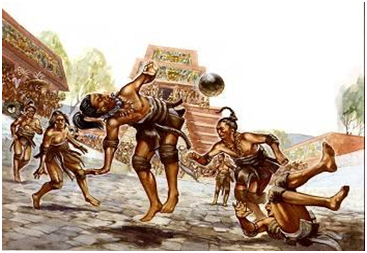
Picture depicts Arawakan men enjoying a game of Batu. Image source: https://caneycircle.wordpress.com/ballgame/
Their favourite pastime was a game called Batu, a ball game which is played within a rectangular playing field known as the Batey. The Batey was rectangular in shape and was a special place for holding meetings and celebrations. It was surrounded by stones and slabs which depicted carvings of animals. The ball was made of rubber and there were two teams who played. The ball cannot be touched using their hands nor feet but instead they played using their hips, elbows, shoulders and head.
Religion
The Arawaks worshiped many gods which were referred to as Zemi. The Zemi controlled various aspects of the universe such as agriculture and weather. They had three primary practices:
- Religious worship to the Zemi themselves
- Dancing during special festivals in honor of the Zemi.
The shaman or medicine men or priests seek advice from the Zemi for healing. They did this by having ceremonies with dancing and singing.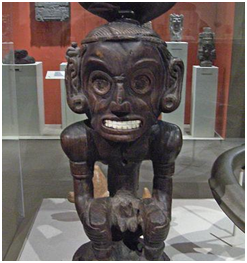
The image depicts a sculpture of the Zemi. Photo Source: <https://commons.wikimedia.org/w/index.php?title=File:Zemi_figure_Metropolitan.jpg&oldid=452626251>
The Arawakan culture is rich and still lives on today, many Amerindians still practice their ancestral roots through dance, songs, food and lifestyle.
If you would like to learn more about the Arawaks in Guyana, visit the Ministry of Amerindian Affairs (moaa.gov.gy) or visit our National Library in Georgetown.
References:
- Their Arrival – http://countrystudies.us/guyana/4.htm (US. Library of Congress)
- The Arawak People – https://youtu.be/oZblVcXltcg
- The Taino Indians of Haiti: Lifestyle, Religion and Dress – http://www.hartford-hwp.com/archives/43a/100.html
- Arawak Language- https://en.wikipedia.org/w/index.php?title=Arawak_language&oldid=1083814917
- Areito – https://en.wikipedia.org/wiki/Areíto
- Batu-https://indiancountrytoday.com/archive/batu-the-ancient-game-lives-on

